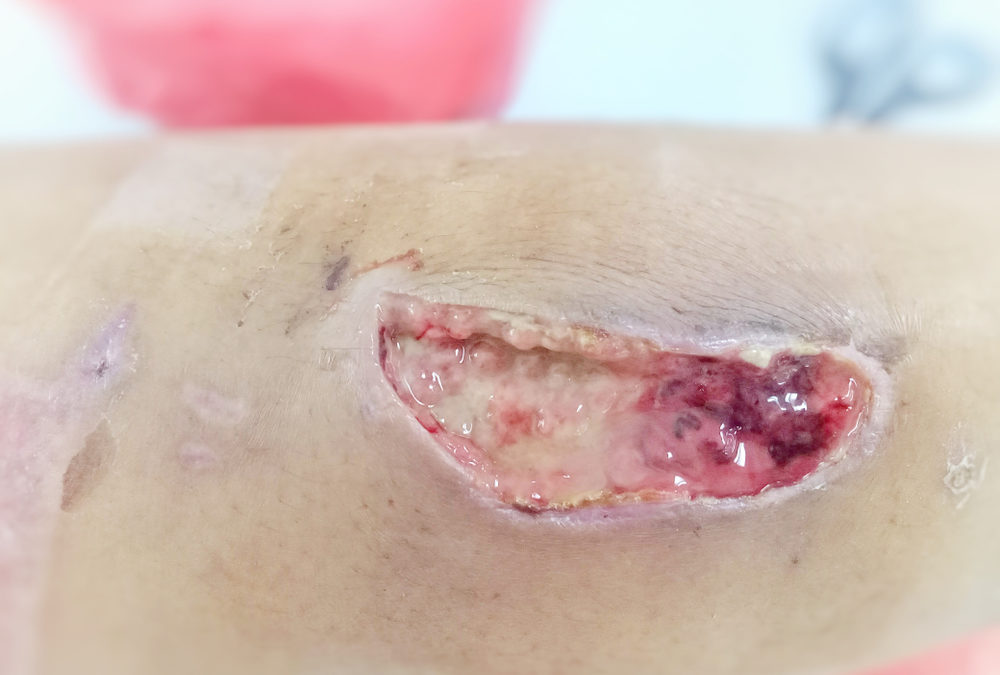Do you remember how you felt the first time you saw this?
Do you still have the photos of the first patient you treated with Negative Pressure Wound Therapy (NPWT)? The photos below are very poor quality because they are Polaroids from 1997! This was one of the first patients I treated with NPWT, only 2 years after the device was cleared by the FDA (Food and Drug Administration). Despite their poor quality, I have kept the photos of this case for 22 years because it’s the first limb that I saved with NPWT. The patient had a failed trans-metatarsal amputation (TMA), and in 1997 there was only one thing to do—a below-the-knee amputation. Yes, you can look at these photos and tell me the wound needed more debridement before I placed NPWT, but remember that at the time, I did not expect NPWT to even work. I put NPWT on this man because I was curious about what would happen, and he was already scheduled for an amputation.
In 1997, the first time I changed an NPWT dressing, I knew that the entire field of wound care had changed. I had been running a wound center for 7 years by then. Most of the time, I could do little more than the 16th-century barber-surgeon, Ambroise Paré, who said, “I dress the wound and God heals them.” In 1997 with negative pressure wound therapy, it became possible to actually harness the healing process. I remember how I felt when I saw what NPWT could do. Even more incredible, we were treating these patients at HOME! I wish I had a photograph of the way one innovative patient created the first “portable” NPWT unit by attaching the heavy device to a skateboard with bungee cords so he could pull the unit behind him, plugged into the wall electrical outlet via a long orange industrial power cord.
We have come a long way in the 23 years since I took these photos. Like you, I now have thousands of high-quality photos of successfully treated patients, but these old photos are special to me.

There’s another thing that has changed over time: the paperwork required to order home NPWT. In the beginning, it was really burdensome because it was pages of paperwork that had to be filled out by hand. In 1997 the Hermann Wound Center (later Memorial Hermann) began using the first iteration of IntellicureEHR. As far as I know, we were the first wound center to move to electronic documentation thanks to Intellicure 23 years ago. To alleviate the burdensome documentation, Intellicure automated the NPWT forms by leveraging the electronic documentation within IntellicureEHR. However, every time the manufacturer changed the form, we had to change programming and we finally gave up the method of “filling out the FAX.” In fact, if NPWT had not been so game-changing, I don’t think that clinicians would have been willing to fill out those burdensome forms because, at the time, there was no way to charge for the time-consuming process of changing the dressing or doing the paperwork. Both the payment system and the electronic ordering system had to evolve to support this new technology.
I could talk about all the initiatives Intellicure has had over the years to automate the NPWT order process. For a while, we even got ahead of the manufacturers’ and distributors’ technology infrastructure and had to wait for them to catch up. It’s taken two decades to get where we are now—a place where NPWT is commonplace and familiar, and in which a purpose-built EHR like Intellicure can be leveraged to relieve the burden of the necessary paperwork.
I hang on to these old photos because I remember how I FELT when I saw what NPWT could do to help patients. It’s harder to represent the way it feels to make the process more efficient, but honestly, it feels just as good to help the practitioners.

Dr. Fife is a world renowned wound care physician dedicated to improving patient outcomes through quality driven care. Please visit my blog at CarolineFifeMD.com and my Youtube channel at https://www.youtube.com/c/carolinefifemd/videos
The opinions, comments, and content expressed or implied in my statements are solely my own and do not necessarily reflect the position or views of Intellicure or any of the boards on which I serve.




I was just talking about the first patient you made me use the wound vac on. It was amazing what it did.
I was a teenager when I saw NPWT heal my grandmother’s lower extremity wounds. I was so amazed! I asked how I could be a part of such an awesome process for healing patients. Now, 20 years later, I’m a Certified Wound Ostomy nurse and clinical educator in a wound healing and hyperbaric HOD department. Absolutely the best field to be in!